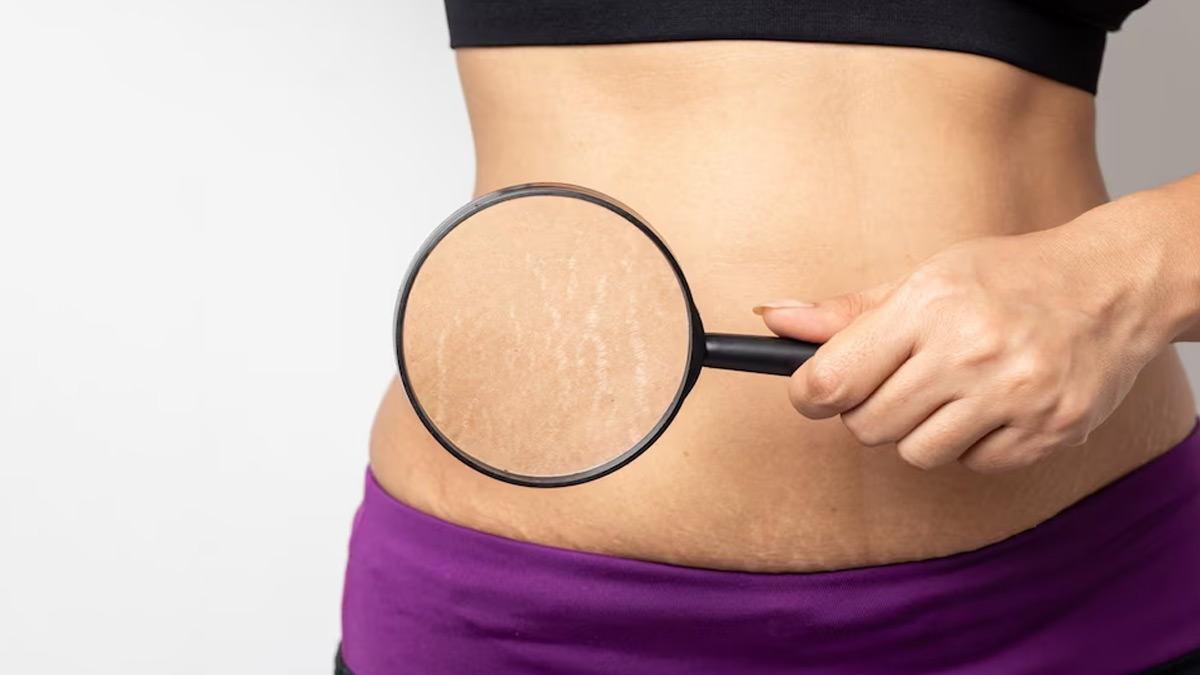
We've all had that moment of surprise and self-consciousness when we notice those mysterious lines on our skin. Stretch marks – they're a common occurrence that can affect anyone, regardless of age or body type. But what exactly are they, and why do they appear?
Table of Content:-
Dr Navya Handa, Dermatologist, Cosmetologist and Laser Surgeon, Primus Super Speciality Hospital, explained stretch marks, their causes, and how to deal with them.
What Are Stretch Marks
Dr Handa said, “Stretch marks, also known as striae, are common skin marks that occur when the skin stretches or shrinks rapidly, leading to the tearing of the middle layer of the skin (dermis). They often appear as red or purple streaks initially and may fade to a lighter colour over time.”
According to the Journal of Cutaneous and Aesthetic Surgery, most often, thighs, abdomens, and female breasts exhibit stretch marks. Also, early stretch marks heal more quickly than later ones.
Causes Of Stretch Marks

Stretch marks develop when the skin is stretched beyond its natural elasticity limits. This causes the collagen and elastin fibres, which provide support and flexibility to the skin, to tear. The resulting marks appear as long, narrow streaks on the surface of the skin. Dr Handa listed some of the common causes of stretch marks as follows:
Pregnancy
As the belly expands to accommodate the growing baby, the skin undergoes significant stretching, especially during the later stages of pregnancy.
Rapid Change In Weight
Rapid weight gain or loss can also lead to stretch marks. When the body experiences a sudden increase or decrease in weight, the skin may not have enough time to adjust, leading to the formation of stretch marks.
Also Read: Exercise Habits That Might Increase The Likelihood Of Stretch Marks
Adolescence
Adolescence is another period when stretch marks commonly appear. During growth spurts, the body undergoes rapid changes in height and muscle mass, causing the skin to stretch and potentially develop stretch marks.
Hormonal Imbalances
Certain medical conditions, such as Cushing's syndrome or Marfan syndrome, and prolonged use of corticosteroid medications can increase the likelihood of stretch mark formation.
Managing and Reducing Stretch Marks

Dr Handa said that dealing with stretch marks involves a combination of prevention and treatment methods. While it may not be possible to eliminate stretch marks, there are steps you can take to manage and reduce their appearance.
Keep your skin hydrated
Dr Handa said, “Moisturising your skin regularly can help improve its elasticity and make it more resistant to stretching. Look for moisturisers that contain ingredients like cocoa butter, shea butter, or hyaluronic acid, which are known to promote skin hydration.”
Maintain a healthy weight
Gradual and steady weight management can minimise the risk of developing new stretch marks. Strive for a healthy weight by adopting a well-balanced diet and incorporating regular exercise into your routine.

Stay hydrated
Ensuring you drink enough water daily helps maintain internal skin hydration, resulting in suppler and less susceptible skin to stretch marks.
Massage and exfoliate
Gently massaging the affected areas with a moisturiser or a specialised stretch mark cream can improve blood circulation and promote collagen production. Regular exfoliation can also help remove dead skin cells, allowing for better absorption of moisturisers.
Also Read: How Many Times Should You Exfoliate Your Face? Know From Expert Dermatologist
Consider topical treatments
Various topical treatments, such as retinoid creams or collagen-stimulating creams, may help reduce the appearance of stretch marks. Consult a dermatologist to establish which course of action is best for you.
Laser therapy
In more severe cases, laser therapy can be effective in diminishing the appearance of stretch marks. This non-invasive procedure stimulates collagen production and encourages the growth of new, healthier skin cells.
Bottomline
Dr Handa concluded, “Embracing one's natural body changes and practising self-acceptance can be crucial in dealing with stretch marks. They are a common part of the human experience, and many people find them to be a normal and beautiful aspect of their bodies.”
Disclaimer
The information in this article is provided by a registered healthcare professional and is for informational purposes only. Hence, we advise you to consult your expert for a diagnosis based on your needs and body type.
Also watch this video
How we keep this article up to date:
We work with experts and keep a close eye on the latest in health and wellness. Whenever there is a new research or helpful information, we update our articles with accurate and useful advice.
Current Version